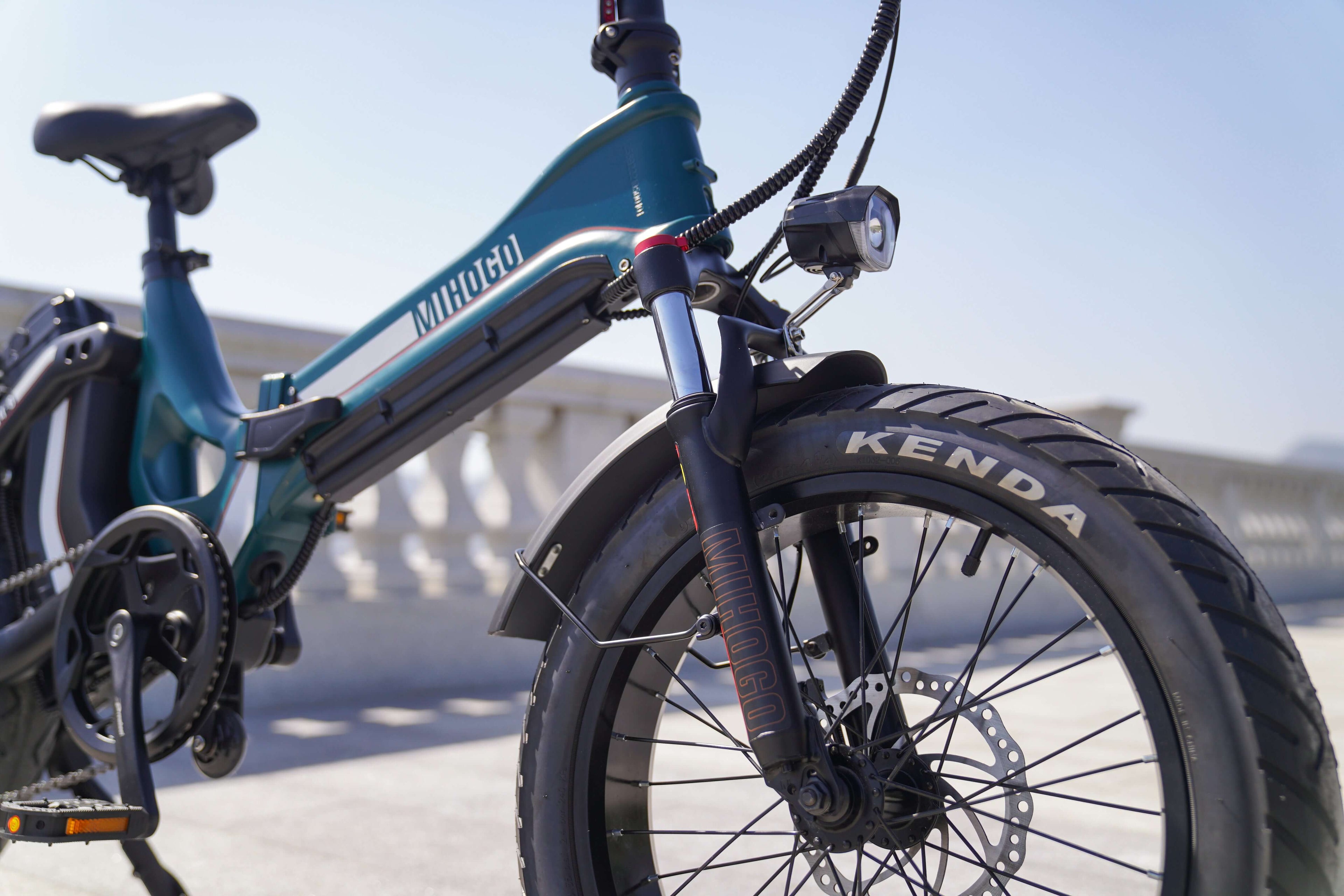The Aging Society Mobility Challenge
Europe's Demographic Transformation
The EU's median age reached 44.7 years on January 1, 2024, reflecting a continent where traditional transportation assumptions no longer apply. As baby boomers enter retirement, they're demanding mobility solutions that preserve dignity, promote health, and maintain social connections.
Research shows remarkable benefits for older e-bike users. Adults ages 50 to 83 who rode e-bikes three times weekly for 30 minutes showed significant improvements in executive function—the ability to plan, organize, and complete tasks. More importantly, e-bike riders performed better in processing speed and enjoyed improved well-being compared to traditional bike riders.
Breaking Traditional Barriers
Traditionally, there's a perception in Europe that e-bikes are for older people who may find regular bikes too taxing. We're reframing this narrative: e-bikes aren't a compromise—they're an enhancement of human capability through thoughtful design.
Human-Centered Design Principles for Aging Users
Understanding Real Needs
Inclusive design ensures that every person—regardless of their gender, location, native language and physical abilities—can enjoy and use products or services. At Mihogo, this philosophy drives every design decision, from frame geometry to user interface.
Physical Accessibility Priorities:
- Joint-Friendly Positioning: Reducing stress on knees, hips, and wrists
- Stable Entry/Exit: Low step-through designs for confident mounting
- Intuitive Controls: Simplified operation requiring minimal dexterity
- Visual Clarity: High-contrast displays readable in all lighting conditions
Cognitive Accessibility Features:
- Predictable Behavior: Consistent system responses reduce confusion
- Progressive Assistance: Gradual power delivery prevents startling acceleration
- Clear Feedback: Audio and visual cues confirm system status
- Emergency Simplicity: One-touch assistance for challenging situations
Mihogo's Age-Inclusive Design Philosophy
MIHOGO ONE Utility EBIKE: Versatile Independence ($1,680)
Our flagship utility model embodies comprehensive accessibility through human-centered design. The MIHOGO ONE addresses multiple aging-related mobility challenges:
Ergonomic Excellence:
- Upright Riding Position: Reduces neck strain and improves visibility
- Wide, Comfortable Saddle: Extended support for longer rides
- Adjustable Handlebars: Accommodate changing flexibility
- Step-Through Frame: Eliminate leg-over barriers
Safety Integration:
- Integrated Lighting System: Automatic activation for visibility
- Stable Wheelbase: Enhanced balance for confident handling
- Progressive Braking: Smooth, predictable stopping power
- Load Distribution: Balanced cargo carrying for shopping and errands
Mihogo Air Max: Smart Simplicity ($1,800)
The Mihogo Air Max represents our vision of technology serving human needs rather than overwhelming users. This model specifically addresses older adults' relationship with modern technology:
Intuitive Interface:
- Large, Clear Display: Essential information at a glance
- Simple Controls: Three-button operation for all functions
- Voice Prompts: Audio guidance for low-vision users
- Smartphone Integration: Optional connectivity for tech-comfortable users
Adaptive Performance:
- Learning Algorithm: System adapts to individual riding patterns
- Comfort Mode: Prioritizes smooth operation over performance
- Range Optimization: Intelligent power management for confidence
- Maintenance Alerts: Proactive system health monitoring
Mihogo Mini: Compact Confidence ($719)
Our Mihogo Mini proves that accessibility doesn't require compromise. This compact model serves older adults with limited storage or those new to electric cycling:
Space-Efficient Design:
- Foldable Frame: Easy storage in apartments or care facilities
- Lightweight Construction: Manageable for upper-body limitations
- Quick Setup: Tool-free adjustment and operation
- Transport Friendly: Car trunk compatibility for multi-modal trips
Beginner-Friendly Features:
- Low Power Mode: Gentle introduction to electric assistance
- Walk Assist: Powered support when not riding
- Training Wheels Compatible: Optional stability for nervous beginners
- Family Sharing: Adjustable for multiple household users
MIHOGO RX 2.4: Adventure Without Limits ($1,080)
The MIHOGO RX 2.4 challenges stereotypes about aging and adventure. This model serves active seniors who refuse to let age define their horizons:
Confidence-Building Technology:
- Terrain Adaptation: Automatic power adjustment for hills and headwinds
- Suspension Comfort: Reduced impact on aging joints
- Range Assurance: Long-distance capability for day adventures
- GPS Integration: Never worry about getting lost
Social Connection Features:
- Group Ride Mode: Synchronized performance for mixed-ability groups
- Emergency Beacon: Automatic alerts for solo riders
- Photo Integration: Easy documentation of adventures
- Community Integration: Connect with local riding groups
Addressing Aging-Specific Concerns
Safety and Confidence
Significant concerns about e-bikes included safety, security, social stigma imposed on electric assistance. Mihogo addresses these concerns through comprehensive design solutions:
Physical Security:
- Anti-Theft Technology: GPS tracking and smart locks
- Daylight Visibility: Integrated reflective elements and lighting
- Stable Handling: Low center of gravity for confidence
- Emergency Features: One-touch assistance calls
Social Acceptance:
- Discrete Integration: Technology that doesn't scream "assistance needed"
- Style Options: Age-appropriate aesthetics without stereotypes
- Performance Flexibility: Match group riding speeds naturally
- Pride-Preserving Features: Maintain sense of personal achievement
Health and Wellness Benefits
E-bike riders rode more than their peers on standard bikes, pedaling more than 30 additional minutes each week. This increased activity translates to significant health benefits:
Physical Health Improvements:
- Cardiovascular Fitness: Low-impact exercise suitable for aging hearts
- Joint Mobility: Gentle movement maintaining flexibility
- Balance Training: Active steering and positioning skills
- Strength Maintenance: Pedal assistance allows continued muscle use
Mental Health Benefits:
- Cognitive Function: Outdoor stimulation and physical activity help prevent age-related cognitive decline
- Independence Preservation: Maintained mobility supports mental well-being
- Social Interaction: Community engagement through cycling activities
- Confidence Building: Successful mobility experiences enhance self-esteem
European Market Context
Regional Adaptation Strategies
In Germany and the Netherlands, e-bikes now make up more than half of all new bikes sold each year. This adoption rate reflects successful integration of aging-friendly design principles.
Germany's Senior Cycling Revolution:
- Infrastructure Support: Dedicated cycling paths reduce traffic anxiety
- Medical Integration: E-bikes prescribed for rehabilitation programs
- Insurance Coverage: Health insurance recognizing mobility benefits
- Community Programs: Senior cycling groups and training courses
Netherlands' Inclusive Approach:
- Universal Design: Infrastructure serving all ages and abilities
- Cultural Integration: E-bikes normalized across all demographics
- Technical Innovation: Leading development of accessibility features
- Safety Focus: Comprehensive traffic calming measures
Government Support and Incentives
European governments increasingly recognize e-bikes as solutions to aging society challenges. Private individuals can receive up to €900 for transport bikes and €500 for folding bikes in various European incentive programs.
Technology Integration for Aging Users
Smart Features That Actually Help
With the rapid growth of mobile technology, ensuring accessibility and usability for older adults has become a critical concern. Mihogo's technology integration follows age-friendly design principles:
Simplified Connectivity:
- Essential Features Only: No overwhelming options or complex menus
- Large Text Display: Readable information in all conditions
- Voice Commands: Hands-free operation for safety
- Emergency Integration: Direct connection to family or emergency services
Adaptive Intelligence:
- Learning Patterns: System remembers preferred settings and routes
- Weather Awareness: Automatic adjustments for challenging conditions
- Health Monitoring: Optional fitness tracking without complexity
- Maintenance Prediction: Proactive service scheduling
Community and Social Integration
Building Connections Through Design
The social stimuli we get exposed to when we bike bring together different generations and social groups. Mihogo e-bikes facilitate these important social connections:
Group Compatibility:
- Speed Matching: Assistance levels allow mixed-ability group rides
- Communication Systems: Integrated intercoms for safer group coordination
- Meeting Point Integration: GPS coordination for group gatherings
- Shared Experiences: Photo and route sharing capabilities
Intergenerational Design:
- Family Sharing: Adjustable systems for grandparent-grandchild rides
- Teaching Modes: Simplified operation for learning experiences
- Safety Redundancy: Multiple protection systems for peace of mind
- Pride Preservation: Features that maintain dignity and independence
Future-Proofing Mobility
Anticipating Changing Needs
Human-centered design means anticipating how user needs evolve over time. Mihogo e-bikes include adaptability features for changing capabilities:
Modular Accessibility:
- Retrofit Capability: Add stability or comfort features as needed
- Control Customization: Adjust interface complexity over time
- Performance Scaling: Modify assistance levels as abilities change
- Service Integration: Connect with healthcare and mobility professionals
Long-Term Support:
- Update Capability: Software improvements delivered wirelessly
- Component Upgrade: Hardware refresh options for extended life
- Training Programs: Ongoing education for changing technology
- Support Networks: Community connections for peer assistance
Real-World Applications
Success Stories and Use Cases
Urban Mobility Solutions:
- Medical Appointments: Reliable transportation to healthcare facilities
- Shopping Independence: Cargo capacity for essential errands
- Social Visits: Maintained connections with friends and family
- Cultural Activities: Access to museums, theaters, and community events
Recreational Freedom:
- Nature Access: Trail riding capabilities for outdoor enjoyment
- Travel Companion: Portable options for vacation mobility
- Exercise Programs: Structured fitness routines with e-bike integration
- Adventure Tourism: Exploring new places with confidence
Implementation Guidelines
Choosing the Right Mihogo Model
Assessment Framework:
- Physical Capability Evaluation: Current mobility and strength levels
- Usage Pattern Analysis: Daily routines and travel needs
- Technology Comfort Level: Preferred complexity of features
- Environment Considerations: Urban vs. rural usage patterns
- Future Needs Planning: Anticipating changing requirements
Professional Consultation:
- Healthcare Provider Input: Integrate with existing care plans
- Occupational Therapy: Optimize setup for individual needs
- Training Programs: Build confidence through structured learning
- Family Involvement: Include support network in decision process
Safety Protocols and Best Practices
Comprehensive Safety Framework
Pre-Ride Safety:
- Daily System Check: Automated diagnostics for peace of mind
- Weather Assessment: Integrated conditions monitoring
- Route Planning: Optimized paths for comfort and safety
- Emergency Preparation: Contact information and backup plans
Active Riding Safety:
- Visibility Systems: Automatic lighting and reflective elements
- Stability Features: Electronic balance assistance where needed
- Communication Tools: Easy access to help when needed
- Traffic Integration: Smart systems for safer street navigation
Economic Considerations
Value Beyond Price
While affordability matters for seniors often on fixed incomes, Mihogo's human-centered approach delivers exceptional value:
Total Cost of Ownership:
- Health Benefits: Reduced healthcare costs through increased activity
- Transportation Savings: Replace expensive car trips and transit fares
- Independence Value: Maintained mobility prevents costly care transitions
- Longevity Design: Durable construction reduces replacement frequency
Financial Accessibility:
- Payment Plans: Flexible financing options for budget management
- Insurance Integration: Work with providers recognizing mobility benefits
- Subsidy Optimization: Maximize available government incentives
- Trade-In Programs: Upgrade paths as needs evolve
Research and Development Commitment
Continuous Improvement Through User Feedback
Mihogo's commitment to human-centered design means continuous evolution based on real user experiences:
User Research Programs:
- Senior Focus Groups: Regular feedback sessions with aging users
- Healthcare Partnerships: Collaboration with geriatric specialists
- Long-Term Studies: Tracking user satisfaction and health outcomes
- Community Engagement: Direct interaction with senior cycling groups
Innovation Pipeline:
- Accessibility Enhancements: Next-generation inclusive design features
- Health Integration: Deeper connection with wellness monitoring
- Smart Infrastructure: Integration with age-friendly city planning
- Emergency Systems: Advanced safety and response capabilities
Global Perspective on Aging and Mobility
Learning from International Best Practices
Statistics show that most e-bike riders were aged between 40 and 70 years up until 2025, indicating significant overlap with aging populations globally. Mihogo incorporates international insights:
Scandinavian Accessibility Models:
- Universal Design Principles: Benefits all users, not just aging populations
- Government Integration: E-bikes as part of comprehensive aging policy
- Technology Acceptance: Gradual introduction of helpful features
- Social Support: Community programs supporting adoption
Asian Longevity Insights:
- Intergenerational Products: Design for multi-age household use
- Health Integration: E-bikes as part of holistic wellness approach
- Community Centered: Social features supporting connection
- Practical Focus: Emphasis on daily utility over recreation
Conclusion: Empowering Aging Through Thoughtful Design
The intersection of Europe's aging society and e-bike innovation presents unprecedented opportunities to enhance quality of life for millions. Mihogo's human-centered design approach transforms e-bikes from simple transportation tools into comprehensive mobility solutions that preserve independence, promote health, and facilitate social connection.
Our four models—the versatile MIHOGO ONE Utility, the intelligent Mihogo Air Max, the compact Mihogo Mini, and the adventurous MIHOGO RX 2.4—each address specific aspects of aging society mobility needs. Through thoughtful engineering, intuitive interfaces, and genuine understanding of user challenges, these e-bikes prove that growing older doesn't mean limiting horizons.
As e-bike riders told researchers they felt more confident in completing requested activities compared to traditional bike riders, the key lies not in the technology itself, but in how that technology serves human dignity and capability. Mihogo's commitment to human-centered design ensures that our e-bikes will continue evolving to meet the changing needs of Europe's aging population.
The future of mobility is not about accepting limitations—it's about designing solutions that expand possibilities. Through careful attention to human needs, thoughtful integration of technology, and deep respect for user experience, Mihogo e-bikes are helping write a new chapter in the story of aging with grace, independence, and joy.
For comprehensive research on aging and mobility, visit the National Institute on Aging or explore inclusive design principles on Wikipedia.






